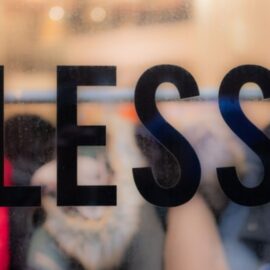

This article gives you a glimpse of what you can learn with Shortform. Shortform has the world’s best guides to 1000+ nonfiction books, plus other resources to help you accelerate your learning.
Want to learn faster and get smarter? Sign up for a free trial here .
Do you beat yourself up for every mistake you make? Do you hang on to shame and guilt for years? Did you know that not forgiving yourself for your mistakes and shortcomings might actually be harming you?
Self-forgiveness is not an easy process because it requires you to accept that you’ve done something against your values, that you’re not comfortable with, or that you’re not proud of. The process of self-forgiveness may take years or even a lifetime because it involves such negative and uncomfortable emotions, however, it’s better to work on it than to stew in guilt, shame, and denial.
Keep reading for self-forgiveness advice from some top books. This article may be just the push you need to start improving your life and state of mind.
Self-Forgiveness Means Recognizing the Good in Yourself
Recognizing the difference between doing bad things and being a bad person—and therefore seeing the essential good in everyone—is a difficult task. It requires looking past harmful behaviors to see each person’s vulnerability and pain.
The first step is to recognize the goodness in ourselves. This often begins with forgiving ourselves for how we feel and what we might have done wrong. Self-forgiveness breaks down the barriers of blame and resentment that we build while trying to protect ourselves from pain. Those barriers are what keep us from experiencing the goodness and love that exists in ourselves and others.
However, there may be times when our guilt and shame are so strong that we can’t forgive ourselves. This is especially the case when we believe that we’ve truly, deeply hurt somebody else. Perhaps we don’t think we deserve forgiveness, or we can’t see the point in it since the damage is already done.
In cases like that, instead of forgiving ourselves, we can try forgiving the shame itself. Rather than fighting the feeling, we can forgive it for existing and welcome it in, like the Buddha welcoming Mara in for tea. In doing so, we will allow the feeling to pass through us and fade away.
We might then find other feelings buried under the shame, such as fear or anger. We can meet those experiences in the same way: We can welcome them in, sit with them, and forgive them for existing.
This practice is effective because we’re giving our experiences permission to be what they are. Instead of trying to control our grief, pain, or shame, we simply allow it to exist—to be as big and powerful as it needs to be.
Learning self-forgiveness and seeing our own goodness takes time and practice. The process starts with mindfulness—we recognize that we’re being judgmental or unkind to ourselves, and we forgive whatever we’re feeling.
Forgiving Isn’t Condoning
Many people misunderstand this practice at first. They tend to think that accepting and forgiving hurtful behaviors is about letting people (themselves or others) off the hook for the pain they caused. However, forgiving a behavior or a feeling isn’t the same as condoning it—self-forgiveness isn’t permission to keep doing harmful things. It’s facing past actions with understanding and compassion so that we can have a clear vision of the present and future.
For example, there are stories of death row inmates who faced up honestly to the harm they’d caused and learned to forgive themselves. By opening up to pain—their own and others’—they awakened compassion within themselves. By doing this, they were able to both take responsibility for the crimes they’d committed and recognize their own innate goodness.
Prisoners who accomplished this were visibly transformed. Guards, relatives, chaplains, and even other inmates all recognized that something had changed—that even though these people were in prison awaiting execution, they’d found a kind of inner freedom.
The main point is this: Holding on to blame and guilt might temporarily stop us from causing more harm, but in the long run it only creates more pain for ourselves and others. We can’t hate ourselves into being good people; only with self-forgiveness can we find the wisdom and compassion to correctly respond to our situations.
There’s No Such Thing as a Perfect Parent
Many women are struggling to keep up with the demands of parenthood, home life, and work. You may feel like you never get a moment’s peace. Other people’s lives look calmer and more organized—this can lead to a sense of blame, shame, and guilt because you think you’re failing as a parent.
In truth, all parents live in a state of chaos, no matter how things appear and the Girl, Wash Your Face author, Rachel Hollis, handles it in one of three ways:
TITLE: Girl, Wash Your Face
AUTHOR: Rachel Hollis
TIME: 30
READS: 34.3
IMG_URL: https://www.shortform.com/blog/wp-content/uploads/2020/01/girlwashyourface_cover.jpg
BOOK_SUMMARYURL: girl-wash-your-face-summary-rachel-hollis
AMZN_ID: B072TMB75T
- Ignore the chaos. Keep your head down and pretend the chaos of family life isn’t there, and work even harder. The problem with this method is that chaos is stressful, and stress can manifest in physical ways. Insomnia, headaches, and hives are some physical manifestations of stress.
- Battle the chaos. We do everything in our power to maintain a picture-perfect existence, furiously cleaning and trying to keep up. The problem with battling the chaos is that we always lose. Life is crazy, stressful and overwhelming, and losing battles against everyday life can make us feel like a failure.
- Drown in the chaos. When we’re overwhelmed by housework, work, kids, friends, and obligations, it can feel insurmountable, so we give up and wallow. The problem with drowning is that we let the chaos win and can’t do the things we need to do—raise our kids and pay our bills.
All three of these coping methods—ignoring, battling, drowning—can lead us down the path of substance abuse, using alcohol, food or pills to deal with the stress. The problem with these three methods is that they imply that you are in control of the mess and chaos around you, but much of this is not in our control. While we may be in control of ourselves, we can’t control much of what we’re dealing with—the actions of others, our children’s moods, problems that crop up. Thinking we can control everything is a recipe for anger, frustration and stress because we are not in control of everything.
How Do We Learn to Accept and Embrace the Chaos?
The answer is to forgive yourself and embrace the chaos—see the beauty in the chaos. This requires a shift in thinking. Our current situation, however stressful, is temporary.
How do we learn to accept and embrace the chaos?
- Cut yourself some slack. We all mess up, scream at the kids, forget events. This loss of control is upsetting, but tomorrow is a new day and a chance to try again.
- Find humor in the situation. Push yourself to laugh at hard situations—the crazier the situation, the more humor you’ll likely find.
- Look for the “fruits of the spirit,” which are love, joy, patience, peace, kindness, goodness, faithfulness, gentleness and self-control. Choose the one that most resonates with you in the stressful moment.
- Take care of yourself. Take a break; take some time out just for you. When you are refreshed, you can better handle all the madness when you come back.
- Find your tribe. Supportive friends in similar situations can help you see you’re not alone.
- Ask for help. Don’t try to do it all yourself; accept any and all offers of help you receive—people who want to watch the kids, bring you dinner, fold the laundry—whatever gives you more space and freedom to find your center, just say yes.
- From a Christian perspective; Understand that God is sending you all kinds of life rafts—get in the boat.
- Change your perspective. Remember that your chaos may be someone else’s dream (family, children, job). This reminds you that your chaos is actually a blessing.
- View the stress and pain as a path to metamorphosis. Think about a caterpillar’s journey into a butterfly. If it stayed a caterpillar, it would never find the beauty in what it’s capable of becoming. It is scary, hard and overwhelming to change your entire being into something new. But if you don’t allow change to turn you into your true self, you’ll never become all you can be.
Concrete Tips for Living in the Chaos of Life
Try these strategies to help cope with the inevitable chaos of home, work and family life:
- Find friends like yourself. Friends who are going through the same thing as you are invaluable—fellow boy parents or girl parents, fellow entrepreneurs or stay-at-home parents, parents with kids the same ages. People who can relate to your day help you feel supported, encouraged and not alone.
- Set priorities. Decide what’s really important to you. You can’t have a perfect home, run a company, train for a marathon, and work out 7 days a week at the same time. Do first what is truly important to you; if something has to wait, that’s life.
- Have a happy place. Whether it’s a glass of wine with friends, HGTV, running or baking, find something that feels like a treat or indulgence, giving you a place to reset.
Parenting During the Pandemic
For many parents, the chaos of the pandemic is compounded by trying to navigate new roles and the loss of routine. This can easily turn into feelings of frustration and self-blame. But, if you accept the need to reshape your parenting identity and forgive yourself for making mistakes while navigating your new norm, then, you’ll discover just how capable you are of taking on this new challenge.
Establishing a New Parenting Identity in a Crisis
Parenting in a crisis begins with acknowledging that the situation will be tough to navigate, and you can’t rely on the routines and roles that carried you to this point. Accepting the hard reality of the situation mentally prepares you to reshape your parenting identity as needed.
When something out of your control happens, the factor that has the largest impact on your children is how you manage it. It’s useless to try to maintain what your children are used to or fret over things you can’t change. Instead, manage the crisis by shifting your parenting identity to work in sync with the new normal.
There are four crucial parts to establishing and maintaining this new identity.
- Decide what type of parent you are. Framing this as an identity creates the powerful belief that this is who you are and makes you feel more capable to deliver on it. For you, this may look like, “I’m a father who can balance a full-time job and homeschooling my kids.”
- Start small. Your behaviors are a reflection of who you are—once you’ve established your identity, perform behaviors that align with it. A working and homeschooling dad might spend 30 minutes each day finding outdoor projects or documentaries that will occupy his kids for long periods of time.
- Improve bit by bit. Changing routines all at once is difficult, and it’s overwhelming to think about how long you’ll need to balance new roles. Instead, focus on improving your new normal a bit each day. For example, this week might see you taking the work-homeschool balance one hour at a time. Next week, you focus on having a full day go as planned. Next, you get through an entire week with only a few hiccups.
- Cut yourself slack. Some days will be better than others—practice self-forgiveness. What’s important is that you keep moving forward with what you can do, instead of giving in to the anxiety of current circumstances.
Finally, especially in the moments of overwhelm, take a moment to reflect on the ways your children fill you with gratitude. For example, homeschooling can feel less burdensome when you appreciate your daughter’s curiosity, or the stress of balancing work and caretaking duties can be alleviated when you admire your son’s energy and imagination.
Learning how to be a different kind of parent in circumstances you can’t control is a drastic change, but it’s likely you’ve made drastic changes for your children before. You just need to learn to forgive yourself for the mistakes you make while you’re creating a new routine.
Self-Forgiveness and Dieting
One major cause of guilt and shame in people’s lives comes in the form of food. So many of us struggle with self-image and eating disorders and it can be difficult not to get upset with yourself when you slip up or go on a binge. But if you allow the guilt and shame to consume you, then the problem may get worse, rather than better, leading to a dangerous cycle.
Here is advice on what to do when you lose willpower from The Willpower Instinct.
TITLE: The Willpower Instinct
AUTHOR: Kelly McGonigal
TIME: 42
READS: 87.9
IMG_URL: https://www.shortform.com/blog/wp-content/uploads/2020/11/the-willpower-instinct-cover.png
BOOK_SUMMARYURL: the-willpower-instinct-summary-kelly-mcgonigal
AMZN_ID: XYZ
When Feeling Guilty Makes Us Give In
It’s a vicious cycle: We vow that we’re going to stop stretching our credit limits in online shopping sprees, but then we get one of those irresistible emails from a favorite store offering 40 percent off if we shop before midnight. So we give in and buy that gadget we’ve been wanting. We feel great about our purchase for about two seconds, but then we feel terrible because we’ve committed another willpower failure. To assuage our regret, we check out a bunch of other shopping sites to see if those stores have any sales, and we buy more stuff we don’t need.
That behavior makes no sense, right? Why not minimize the harm by stopping at one purchase? This is what researchers call the “what-the-hell effect.” We go off our diets by eating one slice of pizza, and then we assuage our guilt and shame by eating three more slices. We know it’s stupid even while we’re doing it, but we can’t stop. Giving in a little makes us feel bad about ourselves, so we give in completely.
To break the cycle, practice self-forgiveness and stop telling yourself that one small setback means you’re a dismal failure. When you criticize yourself in this way, you wind up giving yourself an excuse to indulge more. Your brain feels the sting of your self-hate, and it immediately wants to soothe those feelings, which drives you straight toward whatever temptation comforts you—food, alcohol, cigarettes, shopping, and so on. It’s a downward spiral that’s hard to stop.
In fact, researchers believe we should try the opposite approach—instead of beating ourselves up, we should actually forgive ourselves for giving in. Encouraging words like “don’t be so hard on yourself” can stop a full-on binge before it gets started.
Punishing yourself for failures doesn’t work well with adult brains. Self-criticism is one of the fastest routes to poor motivation and self-control, and it’s also a slippery slope that leads to depression. Self-compassion and self-forgiveness, on the other hand, are the pathways to greater motivation and improved self-control.
Doctors and Fat-Shaming
If self-forgiveness and compassion, rather than guilt and shame, are the answer, then why do doctors think that shaming people will help them lose weight?
- For example, bioethicist Daniel Callahan thinks that people don’t realize they’re obese, or even if they do notice, they’re not motivated to change. He thinks that because shame helped him quit smoking, it’ll help people with their weight too. (In reality, shaming smokers might actually worsen substance abuse because shame makes people less likely to talk to their doctors. Additionally, smoking is an action, and being fat isn’t.)
Bias and shaming can also be unconscious. Most doctors are fit and thin and think that because they manage it, it can’t be that hard. This makes them more confident in prescribing diets and makes them expect big results.
- For example, when Sarah told her doctor that eating less wasn’t working for her, her doctor said she’d eaten one egg and was fine, implying that Sarah should be fine with small quantities too.
Self-Doubt
Similarly, the book The Secret discusses the importance of mindset when it comes to getting healthy. When you have doubts about who you are or what you’re capable of, the universe’s only option is to agree and comply with your thoughts.
- When you say, “I’m not attractive/healthy,” what picture are you creating? What message are you sending the universe?
- When you say, “I am attractive/healthy,” you are summoning the creation of this idea with all your power because you have declared it fact.
When a thought of doubt comes into your mind, the Law of Attraction will summon one doubtful thought after another.
- As soon as a thought of doubt enters your mind, release it.
- Replace it with, “I have the power to create my life, and I know I am receiving what I want now.” Then really feel it.
- The author suggests speaking this affirmation often: “I am whole, perfect, strong, powerful, loving, harmonious, and happy.”
So the next time you slip up on your diet, don’t beat yourself up over it. Instead, forgive yourself for the mistake and work to do better next time. If it were your friend who made the mistake, you wouldn’t hold it over them forever, so why do the same to yourself? Treat yourself like a friend, with compassion and understanding.
Self-Forgiveness and Religion
Many mainstream religions, from Judaism and Christianity to Buddhism and Confucianism, teach that desire causes suffering. While this can be true, the lesson is often delivered with a lack of nuance that only makes matters worse. We come to believe that all desire is sinful, and that feeling it is a sign that we’re flawed and selfish. We berate ourselves for experiencing natural urges, and we fear the intensity of our own passions.
This incorrect understanding of desire leads to a natural—but equally wrong—conclusion. We think that somehow ridding ourselves of all desire is necessary for spiritual growth. An old Chinese story illustrates this misunderstanding, and how it’s common even among deeply spiritual people.
There was an old woman who had allowed a monk to live on her land for 20 years. She reasoned that after so much time, the monk—who was at this point a man in his prime—must have found some degree of enlightenment. She decided to test him: Rather than bringing the monk his food personally, she asked a beautiful young woman to do it for her, and to embrace the monk before she left.
Later that day, the old woman talked to the monk and asked what it had been like to be so close to such a beautiful woman. The monk replied that it had been like a dying tree rooted in a cold rock in winter; in other words, he’d felt no warmth, no life.
The woman was furious. She called the monk a fraud, threw him off her land, and burned down his hut.
Her response is confusing to people who misunderstand desire. To them, the monk’s answer seems virtuous. However, the monk was rejecting his experiences rather than meeting them with Radical Acceptance, then allowing them to pass. That’s not what enlightenment is. The woman understood this basic principle, and the monk didn’t—that’s why she considered him a fraud.
TITLE: Radical Acceptance
AUTHOR: Tara Brach
TIME: 40
READS: 103.4
IMG_URL: https://www.shortform.com/blog/wp-content/uploads/2021/05/radical-acceptance-cover.png
BOOK_SUMMARYURL: radical-acceptance-summary-tara-brach
AMZN_ID: XYZ
Instead of shutting down like the monk, we can encounter our desires using mindfulness techniques. When we find ourselves gripped by desire, we should begin by taking a pause. Don’t immediately chase after what you want; instead, recognize what’s happening to you and take a step back to observe your experience.
Since desire manifests as physical sensations, we can recognize and name those sensations to take away some of their power. Once that’s done, we can invite Mara in for tea: We can forgive ourselves and accept those feelings as our reality of the moment, and allow them to pass through us without ruling us.
For example, the monk from the story could have recognized that he felt the warmth of a young woman’s body pressed against his, and the physical—perhaps sexual—responses it created in him. Having done that, he could have accepted those experiences and allowed them to pass away without any lasting impact.
A key realization that comes from such mindfulness is that those desires and experiences aren’t our faults. We don’t create them, and we’re not to blame for them. They simply exist, and it’s up to us to accept them for what they are. This realization frees us from the fear and shame that come with unmet desires. We come to understand that experiencing desire doesn’t mean we’re flawed or sinful people—we’re simply people who have natural experiences.
Self-Punishment
Sometimes we lack inner peace because we’re punishing ourselves for some real or imagined sin. When you’re unable to forgive yourself for something, you live in a state of constant anxiety that punishment is coming. In these situations, people often work constantly to try to ease whatever guilt they’re feeling. You can find peace of mind in this predicament by releasing your guilt and putting it in God’s hands.
Norman Vincent Peale, the author of The Power of Positive Thinking worked with a hard-driving, nervous, highly pressured man. This man lived with the worry that something sinister was always around the corner. He carried childhood insecurities and guilt from past actions and was constantly in a state of self-punishment. The author prayed with him and asked God to forgive him and set him free. Later the man expressed a sense of healing from this experience. He went on to read the Bible daily and live in health and happiness, finally finding peace in his heart.
TITLE: The Power of Positive Thinking
AUTHOR: Norman Vincent Peale
TIME: 40
READS: 27
IMG_URL: https://www.shortform.com/blog/wp-content/uploads/2020/01/power-of-positive-thinking-cover.jpg
BOOK_SUMMARYURL: the-power-of-positive-thinking-summary-norman-vincent-peale
AMZN_ID: 743234804
Moving Forward
Whether you feel insecure as a parent, you broke your diet and ate a donut, or you made some sort of mistake that hurt another person, you need to learn the act of self-forgiveness. We’re all humans and humans make mistakes—it’s in our nature. However, it’s not the mistakes that define us, but how we act, learn, and grow afterward.

Want to fast-track your learning? With Shortform, you’ll gain insights you won't find anywhere else .
Here's what you’ll get when you sign up for Shortform :
- Complicated ideas explained in simple and concise ways
- Smart analysis that connects what you’re reading to other key concepts
- Writing with zero fluff because we know how important your time is






